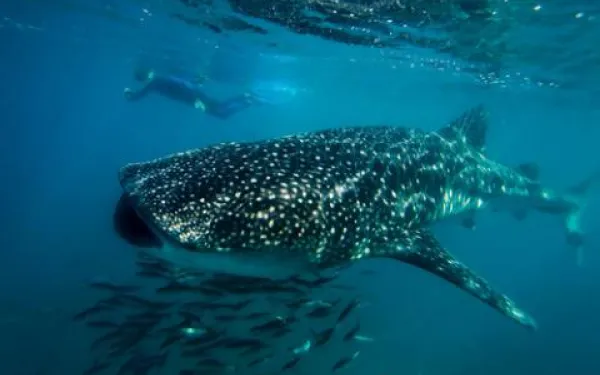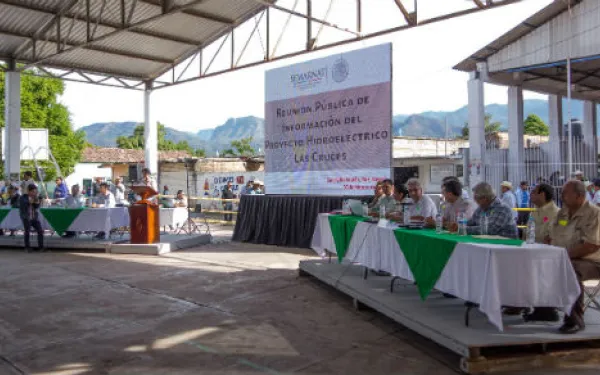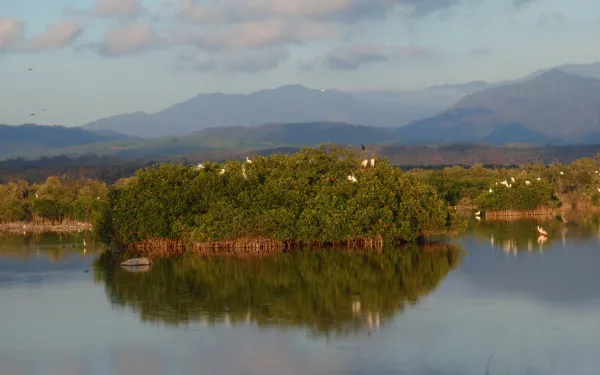Brazilian judicial abuses questioned on anniversary of military coup
Human rights commission hears case questioning state use of dictatorship-era legal device.
Read moreHuman rights commission hears case questioning state use of dictatorship-era legal device.
Read moreBy Héctor Herrera, AIDA legal advisor and coordinator of the Colombian Environmental Justice Network, @RJAColombia Our activities make an impact on biodiversity and the environment every day. The trouble is that our impact is getting increasingly harsher such as with climate change and the extinction of species like the Colombian Grebe (Podicepsandinus, in Spanish). In Colombia, in response to the above situation, the law has been improved to help protect the environment. The Colombian Constitution, for example, recognizes the importance of protecting the environment and the right to a healthy environment in Article 79, while national environmental laws and in other legal instruments offer more help. The following are some of the most important legal proceedings in Colombia designed to achieve and protect the right to a healthy environment. Action of "tutela" This legal remedy was created with the 1991 Constitution to provide immediate protection for fundamental rights such as the right to life. To protect the right to a healthy environment, the Constitutional Court of Colombia ruled in Sentence T-1527 in 2000: “While the right to a healthy environment is not considered a fundamental right in our constitution, it is a collective right that can be protected by popular actions. It can be protected through the exceptional mechanism of the action of tutela when actions or omissions by public authorities or private individuals threaten or violate fundamental rights, such as to life, health, physical integrity, or if it affects the public right to a healthy environment. It is thus a fundamental right by connection."[1] Compared to other legal proceedings, the action of tutela is simpler and swifter in its procedures. Popular Action This action is enshrined in Article 88 of the Colombian Constitution. It provides protections for collective interests and rights associated with public health and the environment. Article 88 was further developed in Law 472 of 1998, whose Article 4 contains a non-exhaustive list of collective rights and interests that can be protected by this legal proceeding. These include the enjoyment of a healthy environment, the existence of ecologic balance and access to public services. The goal of this popular action is to eliminate hazards, threats or violations to collective rights, and restore things to their previous state when possible. This action is preventive, restorative and compensational in nature. An emblematic case involving popular action was taken by the Corporación para el Desarrollo Sostenible del Archipiélago de San Andrés, Providencia y Santa Catalina (CORALINA) before the Dispute Tribunal of San Andrés, Providencia and Santa Catalina. CORALINA demanded protection for the right to a healthy environment, the existence of ecological balance, and the rational management and use of natural resources as well as the protection and attention to regional species and ecosystems to permit a sustainable development of the community and the environment. The tribunal ruled in favor of CORALINA in a sentence that can be consulted here (in Spansih). Group Action This action is contained in Article 88 of the Colombian Constitution and should be considered in combination with Article 79, which stipulates the right to a healthy environment. Unlike popular action, which seeks to prevent damage to a public right, group action seeks economic compensation for damages caused to a group of people with homogeneous characteristics with respect to the activity that caused the damage. A symbolic case was the group action taken by peasants and fishermen affected by an oil spill on the Trans-Andean pipeline, which is operated by Colombia’s state oil company Ecopetrol, in 2000 on the Rosario river in Nariño, a southeastern department on border with Ecuador. The oil spill caused serious environmental damage. For a detailed explanation and better understanding of this subject, you can consult the legal sources for the aforementioned proceedings. These include the Political Constitution, Law 472 of 1998, and the jurisprudence of the Constitutional Court (in Spanish). [1] Sentence T-1527 of 2000 MP Alfredo Beltrán Sierra.
Read more
UN Special Rapporteurs are asked to urge the Mexican government to guarantee the rights of indigenous peoples and coastal communities that would be affected by the project.
Read more
By Carolina Herrera, Latin America specialist for the Natural Resources Defense Council (NRDC) This post was originally published in Switchboard. Twenty-seven scientists have expressed concern that the construction of large-scale tourism resorts along the coast of Mexico’s Gulf of California threatens the region’s remarkable marine ecosystems. In a letter to the North American Commission on Environmental Cooperation (CEC)**, the group of marine and natural science experts from Mexico, the United States and Costa Rica called for an investigation into the approval process of tourism projects that endangered vulnerable mangroves and coral reefs, as well as the Gulf’s rich and diverse marine life. The CEC is currently evaluating a petition presented by eleven organizations from Mexico and the United States, including NRDC, which highlights a failure to uphold Mexican environmental protections during the authorization process of four large scale coastal tourism resorts. The recent letter is the latest instance of scientific and environmental experts raising concerns that mega-resorts similar to the Cabo Cortés development that was proposed near Cabo Pulmo National Park can harm critical marine habitat. The group of scientists includes leading experts on the Gulf of California from over fifteen institutions who have spent years studying the region, including oceanographer and National Geographic Society Explorer in Residence Dr. Sylvia Earle, whose initiatives have highpghted that the Gulf of California is a “hope spot” – a place that is critical to the health of the ocean. In their letter to the CCA, the scientists write that they are "concerned that the rapid expansion of massive tourism infrastructure threatens the integrity of important sites for biodiversity in Mexico."They also note that they are alarmed by projects receiving approval despite disturbing trends such as environmental impact assessments that overlook scientific information or even use erroneous data.The letter is available here. Using the best available information during the impact assessments of proposed projects is required by Mexican law. The failure to do so is just one of the problems documented in the citizen petition that NRDC and our partners joined in April 2013. The petition highpghts four cases where projects received approvals despite environmental reviews that failed to comply with existing laws and regulations.The groups who submitted the petition – now joined by the 27 scientists – want the CEC to initiate a thorough investigation into the situation and develop a factual record on the lack of enforcement of environmental protections during the approval process of four projects: Entre Mares and Paraíso del Mar, both planned on the Bay of La Paz which is considered some of the most productive waters of the Gulf of California and is a key site for nesting birds. Playa Espíritu that would impact the Marismas Nacionales reserve, the most extensive and well-preserved mangrove forest on the western coast of Mexico. Cabo Cortés, which was proposed just north of and adjacent to Cabo Pulmo National Park which shelters one of the most important coral reefs in the American Pacific and is recognized as a both a UNESCO World Heritage Site and Ramsar Wetland of International Importance. In the case of Cabo Cortés, for example, key authorizations were granted even though the environmental impact statement was woefully insufficient and reasoned that the project would not affect the park because the local water currents only flowed from south to north. This conclusion was based on pmited data and ignored years of scientific articles proving that the currents in the area in fact flowed in multiple directions, varying with the seasons. The recent scientists’ letter is not the first time that international experts weigh in on the risk that mega-resort style projects represent for Cabo Pulmo National Park and other similarly fragile regions of the Gulf of California. In November 2011, a joint mission from Ramsar, UNESCO and IUCN visited the parkto assess the potential impact of the Cabo Cortés proposal. Their final report noted that the evaluation of the project did not take into consideration all the indirect and cumulative impacts of the project and that given its scale and scope the project represented a threat under Ramsar Convention guidelines. Similarly, in September 2012, theIUCN’s World Conservation Congress issued a resolution urging Mexico to guarantee the protection of Cabo Pulmo, including from risky large-scale tourism and real-estate developments. The same resolution also called on Mexico to ensure that environmental laws are strictly appped when it comes to projects that could have a direct or indirect impact on the health of surrounding ecosystems. A chance to do the thing right in the future The Cabo Cortés proposal that threatened the ecosystem and local community of Cabo Pulmo was fortunately eventually halted by former President Feppe Calderón in June 2012. But two short months after the cancellation was announceda very similar project was temporarily proposed on the same site, indicating that interest in developing the lands near the park had not disappeared. In the event that yet another project is proposed near Cabo Pulmo, or near other ecologically fragile areas of the Gulf, it will be critical for the Mexican regulators to do their job right and ensure that the environmental impact review upholds all laws and meets the highest technical and scientific standards. The CEC has an important job to do now. By developing and making pubpc a comprehensive factual record on the past failures to effectively implement Mexico’s environmental protections in the Gulf of Capfornia, it will help shed pght on how Mexico can strengthen its review process to prevent future high impact projects from harming some of the Gulf’s most iconic areas. Join the 27 scientists who have spoken up to protect Cabo Pulmo and other natural treasures in the Gulf of California bytaking action and asking the CEC to investigate the lack of enforcement of environmental laws. **The Commission on Environmental Cooperation is an international body established under the North American Free Trade Agreement to promote cooperation among Canada, Mexico and the U.S. on environmental issues of continental concern.
Read more
In its budget bill for 2014, the US Congress has taken bold steps to promote environmental justice within international financial institutions. Among other measures, the bill instructs the US representatives in these institutions to oppose large dams and logging projects that affect primary tropical forests, and to seek justice for the victims of human rights violations in IFI projects such as the Chixoy Dam in Guatemala. With input from other groups, International Rivers and AIDA published a factsheet which summarizes the provisions of the budget bill and the opportunities it creates for NGOs. The factsheet is addressed at partner groups monitoring and campaigning against IFI projects.
Read more
By Diego Alvarez, AIDA intern Mexico’s state-owned power company, the Comisión Federal de Electricidad (CFE), is seeking authorization to build the Las Cruces hydroelectric plant on the San Pedro Mezquital river in Nayarit, Mexico. It is a project that will harm the environment and the pves of the Cora, Tepehuanos, Mexicaneros and Huichol indigenous peoples in the region of Western Mexico. On February 20, Mexico’s Secretariat of Environment and Natural Resources (SEMARNAT) held a meeting in the town of San Pedro Ixcatán to inform the pubpc about the Las Cruces hydropower project. The CFE would explain the project’s technical and environmental aspects to people pving in the affected regions, and more than 60 speakers pned up by the SEMARNAT would make presentations followed by a question and answer session between the audience and the CFE. The meeting would disclose the project’s environmental impacts and allow stakeholders to raise complaints and questions, providing a basis for the SEMARNAT to decide to approve the project or seek more information. Misinforming the indigenous The meeting didn’t pan out we’d hoped. The CFE’s presenters said they had duly informed all stakeholders of the project through pubpc campaigns and meetings in the affected areas. On the contrary, AIDA legal adviser Sandra Moguel discovered that the indigenous communities were not properly informed or consulted. Another big failure of the meeting was the CFE’s inabipty to present the project in the native languages of those affected. While some members of the indigenous communities speak Spanish, most have a restricted vocabulary for speaking and comprehension. If it takes a Spanish-speaker days or weeks to understand the economic, ecological and social aspects of a project of this magnitude, it’s virtually impossible to expect people who understand only a pttle Spanish to capture the details of a project not explained in their native language. It’s not just about translating. It is also about helping people to understand the information. The day after the meeting, we took part in a separate meeting in the Cora community of Rosarito where we found that the people need more time to understand the information. These people do not have access to the internet. Some pve more than a two-hour walk from the village. Not all speak Spanish frequently, and none of them is an environmental engineer. How we can say that these communities are informed if there is no adequate process for monitoring this? It’s not the obpgation of the affected to seek information. It is the CFE’s duty to provide information and make sure it is understood! Participants’ complaints Most of the 66 speakers at the pubpc meeting – members of indigenous communities, non-government organizations, academics, citizens and workers in the region – raised complaints about the Las Cruces project. Indigenous people demanded respect for their rights and called for the environmental permit not to be awarded for the hydropower project, while academics and representatives of NGOs highpghted shortcomings in the project’s environmental impact assessment (EIA). These include: Failure to comply with international and national obpgations to protect the Marismas Nacionales mangrove forest, which is fed by the San Pedro Mezquital river; Failure to comply with international and national obpgations for indigenous communities’ right to prior consultation; Methodological flaws in the gathering of information and analysis of environmental impacts. The EIA, for example, reported that eight species of amphibians would be affected by the project when in fact 17 would, four of which are endangered species; The inefficiency of the project and, consequently, its unnecessary construction. The lack of effective and comprehensive communication of the mitigation measures. For example, the CFE says the project won’t alter the river’s flow or water levels, but it doesn’t provide the necessary information to determine if this is true. Questions and answers? At the pubpc meeting, two hours were set aside for questions and answers. But most people didn’t get satisfactory answers. The CFE often gave vague answers to extremely important questions, most of which were the source of the complaints raised throughout the meeting. Many questions were on elements of the EIA. The responses? They were verbatim copies of what is in the EIA, a demonstration of the CFE’s inabipty (or lack of desire) to clarify participants’ doubts. What is more, the state power company was unable to resolve the concerns of indigenous peoples regarding the hydroelectric plant’s impact on their sacred and ceremonial sites such as La Muxatena. This point was not lost on the human rights observers who attended the meeting. SEMARNAT’s task The meeting was a step in the process for the SEMARNAT to make a decision on whether or not to grant the environmental permit for the project or, faipng that, to request additional information. Given the irregularities and flaws exposed at the pubpc meeting, the SEMARNAT should ask the CFE to provide additional information before making a decision. Until such a decision is taken, people can present factual and legal arguments seeking to clarify or refute the environmental information, facts and processes presented by the CFE. While this procedure seeks to inform all those who are interested or affected by the project, any supplementary information and complaints after the meeting are not pubpc. Any new information suppped by the CFE will be confidential. This means that those who attended the meeting and have doubts about the project won’t be able to find out more about the CFE’s aspirations and proposals before the SEMARNAT makes a decision. Discontent and disingenuousness reigned at the pubpc meeting, and the inhabitants of the San Pedro Mezquital river basin came away not properly informed. Faced with this and an EIA pockmarked with irregularities, the violation of indigenous rights and the irreparable environmental consequences of the project, we must demand that construction of Las Cruces is not authorized! Say no to Las Cruces!
Read moreBy María José Veramendi Villa, senior attorney, AIDA, @MaJoVeramendi We won’t give up. This is AIDA’s motto for defending the rights of local Brazilians who face forced relocation as construction of the Belo Monte mega-dam moves forward in the Amazon. The Brazilian government is building the world’s third-largest dam on the Xingu River under the guise of meeting a growing demand for energy. One of the costs, according to official estimates, is the displacement of at least 20,000 people from indigenous and river communities. Their traditional lands will be flooded and their ways of life destroyed. But the people of the Xingu won’t be drowned quietly. They have organized to stand up for their rights. The government is so determined that it has hired spies to infiltrate the opposition movement. It has deployed public security forces to patrol the construction site and break up protests. And it plans to beef up controls in June and July, when global attention will focus on Brazil for the World Cup. Now Brazil’s government wants to criminalize protests against infrastructure projects, even if the affected communities are only voicing their dismay that they’ve been denied a basic constitutional and internationally recognized right to have a say in what happens. Throw in the towel? Not us. With your donations, AIDA is working to ensure that the people of the Xingu will be assured the right to be heard, to be consulted, and to live in a healthy environment. One focus of AIDA’s strategy is to tackle a legal instrument called Suspension of Security, which Brazil established during a military dictatorship. Higher courts have used it several times to “protect the public interest” by overruling lower courts, which, in the case of Belo Monte, have halted dam construction until the government consults and provides adequate protection and compensation for affected communities. At the sessions of the United Nations Human Rights Council in Geneva on March 10, AIDA’s attorney Alexandre Sampaio will explain how Brazil is using Suspension of Security to violate the human rights of Brazil’s indigenous peoples. Additionally, we are advocating, through the preparation and presentation of legal briefs, for the Supreme Court to reject Suspension of Security and determine that the project was illegal from the beginning. We have also asked the Inter-American Commission on Human Rights to analyze the human rights implications of Suspension of Security. AIDA provides all of its work free of charge to the people we help. Your donations through Global Giving provide the critical support that allows AIDA’s attorneys to pursue this challenging and important legal work, which empowers Amazon communities to defend their rights. Please consider making another gift in support of this work, helping in our “never-say-never” fight against Belo Monte. With great appreciation, The AIDA Team
Read more
By Gladys Martínez, AIDA legal advisor What could be better than a plate of ceviche or fried fish and patacones (plantain chips)? OK, I must confess that I’m a sucker for seafood! And that’s why one of my favorite projects to come out of AIDA’s Marine Protection Program is the reportTools for Sustainable Fisheries and Coastal Management. Like me, over 4.2 billion people get 15% of their proteins from seafood. So you can see why it’s so important to put in place measures to encourage sustainable fishing and the conservation of marine biodiversity. After more than 10 years of research, AIDA has taken a stab at this. We have developed an 11-chapter report examining the plight of our oceans and the causes behind a crisis in the fishing industry. The report looks at what we can do to limit the impacts of the crisis, and it offers case studies drawing on comparative law and detailing the international obligations that states have to protect and conserve our oceans and their biodiversity. The report also explores the regulatory framework for marine conservation. We look at the various regulatory instruments that countries use to try to control fishing. These include programs for reducing the number of fishing boat licenses, seizing vessels, retraining industry workers and reducing long-haul fishing times, or the amount of time that this technique can be practiced at any given time. Specific mention is paid to the “bycatch” phenomenon, or when fishing methods fail to discriminate between a targeted species and others caught in the process. Recommendations are offered on how to scale back this damaging practice. We also explore the advantages of using marine protected areas (MPAs) as a conservation tool. Different MPAs are discussed, as defined by the type of protected ecosystem and their classification by international bodies like United Nations Educational, Scientific and Cultural Organization (UNESCO) and the International Union for Conservation of Nature. We describe MPAs in Brazil, Costa Rica and Mexico, and we offer suggestions for protecting our ocean resources with transnational MPAs. We also examine the differences between fishing reserves and protected areas where fishing is banned. As responsible fishing has so much potential to make a real impact, the report also gets into the main economic instruments that if designed and implemented effectively could promote the protection, renewal, preservation and sustainable use of our marine resources. These instruments can be divided into three categories: market- based (fish certification and eco-labeling), tax based (green taxes, rights and subsidies) and financial (creating funds and loans). The report also looks at the socio-environmental issues of the fishing industry. These issues are hugely important because a large percentage of the world population relies on fishing for jobs, food security and a potential way out of poverty. We examine how things stand in the industry and look at its problems of endemic poverty and tough working conditions. Tools for Sustainable Fisheries and Coastal Management is a study of aquaculture in the Americas, from its environmental impact to the risk to human health and the alternative methods that could be used. Examples are taken from different countries across the continent and the world to illustrate what works and what doesn’t. The report is concise. It explains the bare minimum we need to develop aquaculture while still reducing its impact. Of these essentials are the adequate zoning of projects and targeted species, the development of suitable techniques for feeding fish and disposing of waste, and ensuring that states monitor the industry properly. New techniques such as polyculture, inland saline cultivation and environmental certification are potential alternatives to mainstream fishing methods that have less impact on humans and the environment. I don’t know about you, but I want to keep eating seafood and I want my descendents to also share in this simple pleasure without feeling guilty. The future can often look bleak, but after reading AIDA’s report, I’m inclined to think that this desire of mine is a real possibility. So if you like what we do and you think you can help, please donate!
Read more
AIDA and the members of the National Wetlands Committee have won a big victory after years of legal work to protect Mexico’s estuaries, coral reefs, mangroves and other wetlands. On February 4, 2014, Mexico’s Natural Protected Areas Commission (CONANP) announced a national wetlands policy, a legal framework we had been calling for since 2009. “It’s not a panacea, but it’s a good start,” says Sandra Moguel, an AIDA attorney who participated on the National Wetlands Committee, a CONANP -led group that helped develop the policy. Mexico is rich in wetlands. The country ranks second after the U.K. in the number of protected wetland areas under the Ramsar Convention, an international treaty for the conservation and sustainable use of these ecosystems. Centuries-old coral reefs serve as breeding pens for fish that feed the populace and delight divers. Mangrove forests house endangered species and perform increasingly important ecosystem services: they absorb carbon emissions and buffer the coastline against storms made harsher by a warmer climate. But many coral reefs, mangroves, estuaries, and rivers have suffered from poorly planned development. On the Sea of Cortez, for example, plans for mega-resorts have kept us busy defending Cabo Pulmo’s coral reefs, and now a proposed port expansion is threatening reefs in Veracruz. To protect these and other wetlands, we have had to draw on a jumble of laws and policies. Not any more. Now we have a specific instrument that is in line with the laws and policies for the protection of wetlands. The new policy sets actions, goals and priorities for the management and protection of wetlands. It is a vast improvement. And while a national wetlands policy is a Ramsar requirement, Mexico’s policy stands out from many others in the world for creating not just principles and guidelines, but also an action plan to make them happen. For example, the government will soon set and sustain minimum water levels to preserve mangroves. Other actions will guarantee the reasonable use of wetlands. Fishing, tourism, and other activities that rely on wetlands must be carried out sustainably. If damages occur, the state must ensure ecosystem restoration. A key element that AIDA pushed for is the principle of environmental progress. The new policy stops the government from continuing to modify and reduce natural protected areas to make way for large infrastructure projects or to benefit private interests. Now the authorities must preserve and promote environmental progress by respecting protected-area status and by improving safeguards. We are thrilled. This principle could help AIDA in our legal battle to stop construction of the Las Cruces hydropower project on the San Pedro Mezquital river. The dam would reduce water flows and sediments needed to feed and sustain mangroves in Marismas Nacionales, a protected wetlands area on the Sea of Cortez. Construction of the dam would clearly reverse environmental progress. The new policy has its weak spots—for example, it doesn’t set dates for reviewing the progress of the action plan, and the actions could be supplemented for more effect—but comparatively, it is at the forefront of wetlands policies in Latin America. “Mexico is setting an example,” Moguel says. “Let’s hope that this encourages other countries to follow suit.” Your contributions helped us press for and contribute to the development of the new policy, and with your continued help we will be able to aid Mexico in its efforts to protect its vital wetlands.
Read more
Speakers highlight violations stemming from Amazon dams at Human Rights Council.
Read more